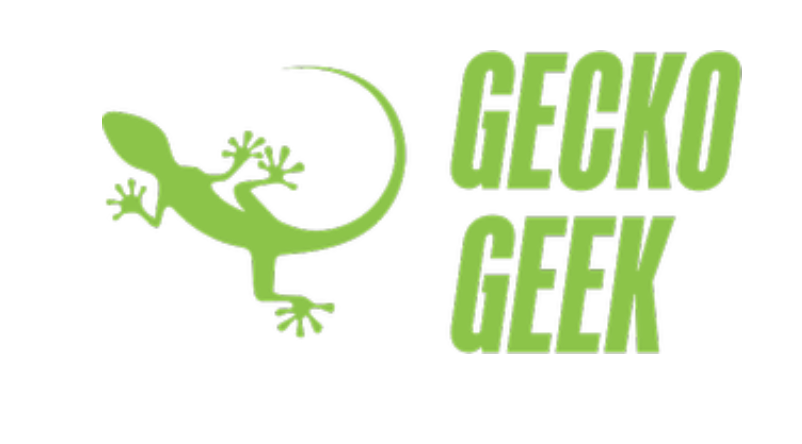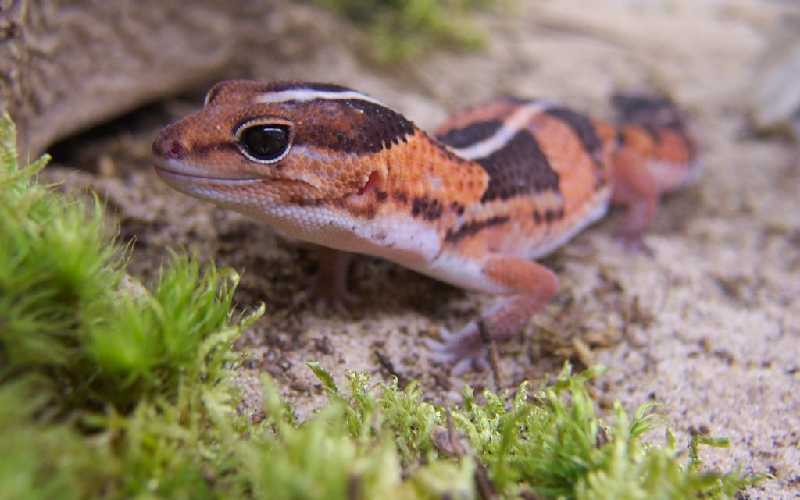Originating from the West African desert, the African Fat-Tailed Gecko is rising in popularity amongst reptile owners. Whilst they are yet to be widely available in-store, there is lots of availability with specialist African Fat-Tailed Gecko breeders online.
The Hemitheconyx caudicinctus are most active at night and in darkness, however, make great pets due to their readiness to become submissive and handled by humans.
Although the African Fat-Tailed Gecko is painted in a prominent brown shade, their uniqueness comes in their tanned stripes and a single long white stripe.
They can grow up to 9 inches in length, with the most youthful hatching at just 2 inches. Their bodies are well known not just for their unique colouring but also for their large heads and feet. If you’re not sure whether you’ve spotted a male or a female, check the size of its head as males tend to have slightly larger front ends.
Fun Fact: The African Fat-Tailed Gecko is one of the only gecko species to have eyelids. This means they can thrive in natural habitats such as the West African desert.
How to look after it
The Fat-tailed gecko will live anywhere up to 20 years in its enclosure. Therefore, it is important that you keep its environment in a condition that can keep your gecko both happy and safe.
Whether you’re owning a single gecko or multiple, there are a few things you should know about housing these incredible reptiles. Two males should not be housed together – they will fight aggressively to protect their territory. However, a male and a female or even a male and a few female geckos can be housed perfectly happily together.
For a pair of gecko’s, a 10-gallon aquarium will work great, giving them ample room to move about and thrive in a replicated home environment.
Heating & Lighting
We mentioned earlier that the fat-tailed gecko thrives in night conditions. However, you can’t keep it dark all the time. For best health, keep light on for half the day (12 hours) – however, you will not need to purchase a UVB light that most gecko owners will have to.
Provide heat from below the enclosure using a heating pad placed underneath – typically we recommend a thermostat to go along with it to help regulate temperature.
Whilst you won’t need a UVB light – it is important to keep the heat high in your enclosure. Geckos can’t generate their own heat and as a result, need it to be provided for them. Place your basking lamp or heat source at one end of the enclosure turned up to roughly 90 degrees Fahrenheit. The cooler area of your enclosure should then drop to 70 degrees Fahrenheit allowing your pet to thermoregulate.
Reptile shelters will work wonders with your fat-tailed gecko, offering them a safe place to hide and sleep. You could go all out and purchase a high-end reptile shelter – but they will also be perfectly happy with an upside-down plastic container with a hole cut out acting as an entry point.
To assist with the shedding process, when eventually it comes around, you will want one side of the enclosure to be moist (cooler end) whilst the other end may remain dry. The two different environments help to replicate their natural habitat – however, you can have two different reptile shelters in both places in each environment.
Substrate – What to put at the base of the enclosure
It is relatively simple for first owners to house these reptiles. Your gecko will be perfectly happy in the newspaper laid down at the base of its home.
You may be thinking sand is the best substrate considering their home environments, however, it is recommended not to put sand down as if ingested – can become harmful.
Food and Water
The African fat-tailed gecko will happily munch away on crickets and mealworms. Live reptile food is a must when it comes to keeping your pet happy, and whilst silkworms are great – they are high in fat and should only be given in rare circumstances.
An adult gecko should be fed 3 times a week with 9 mealworms or crickets each time. That equates to 18 crickets or mealworms weekly.
A baby gecko (under 4 months) requires a little more and should be fed 5 every day equalling around 35 a week.
For added nutrition, you can ‘gut-load’ insects so that they can digest more nutrients. During this process, ensure that you dust the insect with calcium powder and vitamins once a week.
If you’ve decided to feed your gecko crickets, you can just place the food inside the enclosure and leave them to roam around. However, if your new pet hasn’t touched them in a few hours, make sure to remove them from the enclosure.
Water is imperative to your gecko’s health. Many owners own a reptile water bowl and keep it filled with fresh water constantly.
Handling
With regular contact and handling, your African fat-tailed gecko will grow with confidence and their shyness will slowly fade away. However, they are still lizards that like to hide in the darkness so don’t be alarmed if they don’t want to come out and play.
Please note, their tails are extremely sensitive, and they should not be held as such. Like in the wild, if they feel threatened / are injured they can detach their tail and grow a new one – however, it certainly won’t look the same.
If you enjoyed this article you might also like to read about Frog eyed Gecko Care


2 thoughts on “African Fat-Tailed Gecko Care”